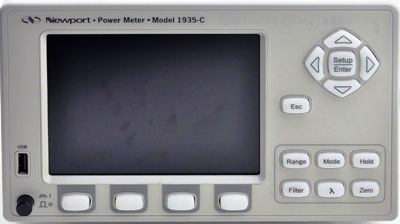
|
|
The Newport 1935-C Optical Power Meter is perfect for measurement of low/high-power or low/high energy of continuous or pulsed light sources. This unit can handle repetition-rates of up to 10 kHz at a sampling rate of 250 kHz. Pulse, peak-to-peak and DC source measurements can be displayed in units of W, dBm, dB, J, A, and V. Low-power measurements, of pW to several Watts can be accomplished with any one of the Newport 918D Series Silicon (Si), Germanium (Ge) or Indium Gallium Arsenide (InGaAs) Detectors, covering 190 to 2550 nm wavelengths. The 918D Series includes the model 918D-IG-C1 Detector with a built-in Peltier cooler, designed to work with models 1935T-C and 2935T-C Power/Energy Meters. The internal TE cooler drive electronics featured in these instruments replace an external benchtop driver, providing a more economical and space-saving solution. All 918D Series Detectors have a built-in temperature sensor utilized for sensing and actively compensating for temperature-induced measurement fluctuations. Energy measurements of pulsed laser sources, from 7 mJoule to 20 kJoules can be taken with these meters, using pyroelectric detectors. Pulse repetition rates from single shot to 10 kHz can be measured directly without having to rely on oscilloscope measurements. The Newport 818E Series (Energy Detectors) Pyroelectric Detectors, operating in the 0.19–20 mm wavelength range, are fully compatible with these instruments. True Root-Mean-Square (rms) measurements, providing the most accurate rms value regardless of the shape of the input waveform. Advanced features include user defined display colors, an internal 250,000 data point storage buffer, additional data storage using an external USB flash drive (memory stick), analog and digital filtering, programmable sample rates, moving statistics, plotting and multiple user-configuration storage. Features. Measurement rep-rates up to 10 kHz. True rms measurements. Power measurements, 1 pW – 20 kW. Pulsed and integrated energy measurements, 7 µJ to 20 kJ. Frequency measurement of pulses up to 250 kHz. Accelerated thermopile based power measurements with fast prediction algorithm. Data storage via internal memory or USB and RS-232 computer interfaces. Color plotting, statistics and on-board data post-processing. Analog and digital filtering. Trigger in/out control with alarm levels.
|